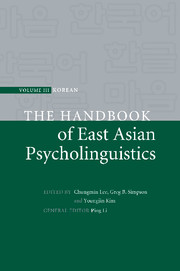Book contents
- Frontmatter
- Contents
- List of figures
- List of tables
- List of contributors
- Preface
- Introduction: Advances in Korean psycholinguistics
- Part I Language acquisition
- Part II Language processing
- 28 Visual processing of Hangul, the Korean script
- 29 English vowel spaces produced and perceived by Americans and Koreans
- 30 Morphological representation and processing of Sino-Korean words
- 31 The role of phonology in word recognition of Korean Hangul and Hanja
- 32 Lexical and sublexical processes in Korean word recognition
- 33 Prosody in sentence processing
- 34 Korean sentence processing
- 35 Sentence processing and memory representation in Korean
- 36 Understanding complex sentences: memory constraints and informational structure
- 37 ERP studies of Korean language processing: word-order effects
- 38 Inferences during discourse comprehension in Korean
- 39 Morpho-syntactic processing in Korean aphasics
- 40 Morpho-syntactic processing of Korean-speaking adults with Broca's aphasia
- 41 Comprehension deficits in Korean agrammatic aphasia
- 42 Developmental reading disorders in Korean
- 43 Individual differences in Korean language processing: context-dependent processing of skilled readers in word ambiguity resolution
- 44 A computational model of lexical and morphological processing in Korean
- References
- Name index
- Subject index
33 - Prosody in sentence processing
from Part II - Language processing
Published online by Cambridge University Press: 05 June 2012
- Frontmatter
- Contents
- List of figures
- List of tables
- List of contributors
- Preface
- Introduction: Advances in Korean psycholinguistics
- Part I Language acquisition
- Part II Language processing
- 28 Visual processing of Hangul, the Korean script
- 29 English vowel spaces produced and perceived by Americans and Koreans
- 30 Morphological representation and processing of Sino-Korean words
- 31 The role of phonology in word recognition of Korean Hangul and Hanja
- 32 Lexical and sublexical processes in Korean word recognition
- 33 Prosody in sentence processing
- 34 Korean sentence processing
- 35 Sentence processing and memory representation in Korean
- 36 Understanding complex sentences: memory constraints and informational structure
- 37 ERP studies of Korean language processing: word-order effects
- 38 Inferences during discourse comprehension in Korean
- 39 Morpho-syntactic processing in Korean aphasics
- 40 Morpho-syntactic processing of Korean-speaking adults with Broca's aphasia
- 41 Comprehension deficits in Korean agrammatic aphasia
- 42 Developmental reading disorders in Korean
- 43 Individual differences in Korean language processing: context-dependent processing of skilled readers in word ambiguity resolution
- 44 A computational model of lexical and morphological processing in Korean
- References
- Name index
- Subject index
Summary
Introduction
Prosody refers to a grouping within an utterance and the prominence relations between the members within the group. Groupings within an utterance, called prosodic units, are hierarchically organized so that a prosodic unit can include one or more smaller prosodic units. Since the grouping and the prominence relations between the members are often marked by intonation, the terms ‘intonation’ and ‘prosody’ are often used interchangeably. Intonation, though traditionally defined as the global changes in pitch over the course of a sentence or a phrase, has an internal structure. Some pitch events mark the boundaries of groupings, either small or large, while others mark the prominent members within a group. In this way, an intonation contour marks a hierarchy of groupings and reflects the metrical structure of the group. The pitch events marking the internal structure of intonation can be represented by two distinct pitch levels, High (H) or Low (L) and their combinations (e.g. HL for falling and LH for rising). This view of intonation is known as an autosegmental-metrical model of intonation or intonational phonology, started in the late 1970s and early 1980s through the seminal works of Bruce (1977) on Swedish intonation and Pierrehumbert and her colleagues on English intonation (e.g. Pierrehumbert, 1980; Beckman & Pierrehumbert 1986; Liberman & Pierrehumbert, 1986; Pierrehumbert & Hirschberg, 1990).
This model of intonation has been applied to Japanese (Pierrehumbert & Beckman, 1988) and Korean (Jun, 1993), and has been expanded to many other languages including German (Grice & Benzmüller, 1995) and Greek (Arvaniti & Baltazani, 2005; see S.-A. Jun, 2005 for a similar analysis of eight other languages).
- Type
- Chapter
- Information
- The Handbook of East Asian Psycholinguistics , pp. 423 - 432Publisher: Cambridge University PressPrint publication year: 2009



